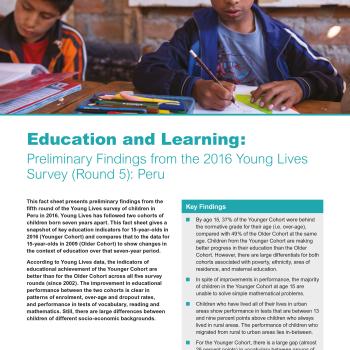
Round 5 Longitudinal Education and Learning Fact Sheet
This fact sheet presents findings from the fifth round of the Young Lives survey in Peru in 2016. Young Lives has followed two cohorts of children born seven years apart. This fact sheet gives a snapshot of key education indicators for 15-year-olds in 2016 (Younger Cohort) and compares that to the data for 15-year-olds in 2009 (Older Cohort) to show changes in the context of education over that seven-year period. According to Young Lives data, the indicators of educational achievement of the Younger Cohort are better than for the Older Cohort across all five survey rounds (since 2002). The improvement in educational performance between the two cohorts is clear in patterns of enrolment, over-age and dropout rates, and performance in tests of vocabulary, reading and mathematics. Still, there are large differences between children of different socio-economic backgrounds.
Key Findings:
By age 15, 37% of the Younger Cohort were behind the normative grade for their age (i.e. over-age), compared with 4% of the Older Cohort at the same age. Children from the Younger Cohort are making better progress in their education than the Older Cohort. However, there are large differentials for both cohorts associated with poverty, ethnicity, area of residence, and maternal education. In spite of improvements in performance, the majority of children in the Younger Cohort at age 15 are unable to solve simple mathematical problems. Children who have lived all of their lives in urban areas show performance in tests that are between 13 and nine percent points above children who always lived in rural areas. The performance of children who migrated from rural to urban areas lies in-between. For the Younger Cohort, there is a large gap (almost 25 percent points) in vocabulary between groups of children that are noticeable from age five. This gap diminishes slightly, to 16 percent points, by age 15.
Round 5 Longitudinal Education and Learning Fact Sheet
This fact sheet presents findings from the fifth round of the Young Lives survey in Peru in 2016. Young Lives has followed two cohorts of children born seven years apart. This fact sheet gives a snapshot of key education indicators for 15-year-olds in 2016 (Younger Cohort) and compares that to the data for 15-year-olds in 2009 (Older Cohort) to show changes in the context of education over that seven-year period. According to Young Lives data, the indicators of educational achievement of the Younger Cohort are better than for the Older Cohort across all five survey rounds (since 2002). The improvement in educational performance between the two cohorts is clear in patterns of enrolment, over-age and dropout rates, and performance in tests of vocabulary, reading and mathematics. Still, there are large differences between children of different socio-economic backgrounds.
Key Findings:
By age 15, 37% of the Younger Cohort were behind the normative grade for their age (i.e. over-age), compared with 4% of the Older Cohort at the same age. Children from the Younger Cohort are making better progress in their education than the Older Cohort. However, there are large differentials for both cohorts associated with poverty, ethnicity, area of residence, and maternal education. In spite of improvements in performance, the majority of children in the Younger Cohort at age 15 are unable to solve simple mathematical problems. Children who have lived all of their lives in urban areas show performance in tests that are between 13 and nine percent points above children who always lived in rural areas. The performance of children who migrated from rural to urban areas lies in-between. For the Younger Cohort, there is a large gap (almost 25 percent points) in vocabulary between groups of children that are noticeable from age five. This gap diminishes slightly, to 16 percent points, by age 15.
